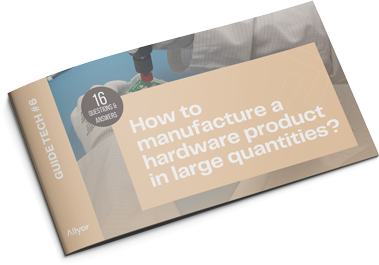Are you launching a hardware product and want to avoid costly mistakes? You’re right to do so. The transition from prototype to series production is a sensitive stage. Without preparation, the risks are high: cost overruns, delays, quality issues.
In this article, we share five essential tips for successfully mass-producing your hardware product. They are based on our field experience and the best industrial practices applied at Altyor.

Industrial manufacturer for
over 25 years

Over 700,000 products per year
including 100,000 in France

Responsible manufacturing
5 tips for a successful transition to mass production
Verify product industrialization from the design stage onwards using DFM
Before mass production, it is essential to confirm that the product is truly industrializable.
Imagine: your product has been designed, the prototypes are working… but once in production, it is impossible to assemble it in series without repeated defects.
That is exactly what DFM (Design For Manufacturing) does. It identifies design weaknesses, optimizes parts, and prevents repetitive defects. Good DFM is like insurance: it prevents unpleasant surprises once you’re in the factory.
At Altyor, the design office carries out this analysis upstream. This provides assurance against unpleasant surprises. Good DFM improves quality, reduces waste, and secures the overall budget.
Before finalizing your design and moving on to industrialization, ask your design office:
“Can this product be manufactured in large quantities without additional costs or waste?”
Securing the supply chain before production begins
The supply chain can become a point of weakness. Component shortages, supplier delays, dependence on a single reference… all these risks must be anticipated before production begins.
The solution? Multi-sourcing electronic components. Identify multiple suppliers for critical components, integrate validated alternatives, and secure your electronic BOM.
The solution? Multi-sourcing electronic components. Identify multiple suppliers for critical components, integrate validated alternatives, and secure your electronic BOM.
Gradually ramp up production to stabilize output
Many want to go from 10 prototypes to 10,000 units in a single step. This is a common mistake. It causes stress in production, defects, and delays.
The right approach is to proceed step by step.
First, produce a few dozen units to validate the tools. Then produce a few hundred to train operators and adjust processes. Finally, gradually ramp up to mass production.
This controlled ramp-up ensures stable production and significantly reduces quality risks.
👉 Discover how Altyor supports its clients in moving from a functional prototype to mass production.
Integrate sustainability from the earliest stages of design
Sustainability is not something that is added at the end of a project. Responsible production is not just a marketing ploy. It must be integrated from the outset.
This involves eco-design: reducing materials, choosing recycled plastics, and optimizing repairability.
It also involves rigorous waste management in the workshop: selective sorting in the workshop, partnerships with recyclers for electronic cards and batteries, and recovery of production waste.
Finally, don’t forget the traceability of components in relation to conflict minerals issues, or REACH compliance.
At Altyor, these requirements are part of our industrial commitment to successfully mass-produce your projects.

Choisir un sous-traitant fiable pour un partenariat long terme
The choice of industrial manufacturer is strategic. It directly influences the quality, costs, and success of your project.
Comparing prices alone can be misleading. Two quotes may show very different amounts simply because one details each item (tools, tests, quality controls, assembly steps) while the other simply gives a much more attractive overall price… at first glance.
The real difference lies in transparency. A clear, structured, and comprehensive quote allows you to understand exactly what you are purchasing, anticipate future costs, and avoid unpleasant surprises during production. Conversely, a quote that is too vague often hides options, steps that are not included, or additional costs that will appear once the project is underway.
Also take the time to check one essential point: ownership of tools and industrialization files. These elements are at the heart of your product. If you do not own them, you become dependent on your subcontractor. This can complicate a change of supplier, slow down your product developments, or even create a risk to industrial continuity. By ensuring that everything belongs to you, you retain control over your production, quality, and long-term strategy.
A good subcontractor shares your values and vision, and supports you over the long term. They are a partner, not just a service provider.
👉 Boost the reliability of your project with Altyor, your industrial manufacturing partner for mass production.
Get a quote tailored to your project!
Anticipate pitfalls to ensure successful mass production of your electronic product
By applying these five tips, you greatly increase your chances of successfully mass-producing your hardware product. You control your costs, reduce risks, and ensure final quality.
To learn more, download our guide “How to manufacture a hardware product in large quantities.” And if you would like personalized support, the Altyor team is at your disposal.

How to manufacture a hardware product on a large scale?
Going from prototype to production is a critical turning point. Wrong choice of partner, quality defects, delays… a mistake can be costly.
This guide, designed by Altyor’s experts, will help you structure your approach and avoid the pitfalls. You will find clear advice on how to manage your production with peace of mind.
